The Stream tool offers two audio-visual stream options: one is your own individual stream, and the other is the Meeting – this embeds a Jitsi meeting directly in the live stage.
The Meeting tool invites everyone present on the stage – audience as well as players – to share their mic and webcam. This is very useful for presentations and training sessions, participatory performances or post-show discussions.
When you use either of these tools, your browser will ask you to “allow” or “share” your webcam and microphone; you can save these settings in your browser if you don’t want to be asked every time.
This chapter first explains the Meeting tool, and then the individual stream.
Create a Meeting
Click on the “Streams” icon in the left-hand menu, and a tool overlay appears at the top of the screen showing a plus sign and “Create Meeting”.
Click on “Create Meeting” and a pop-up window opens asking you to name the room.
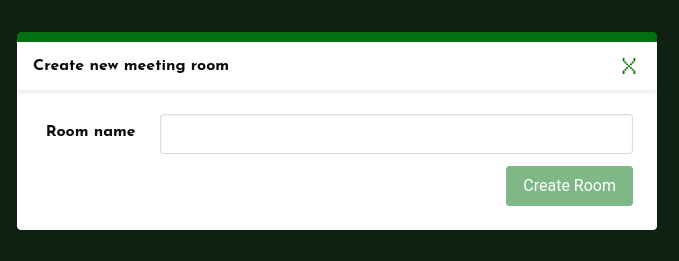
Give the room a name. This will be visible to everyone at the top of the meeting window, so use a name that makes sense within your performance.
Click “Create Room” and you’ll see its icon appear in the overlay. Drag the icon onto the stage.
As with other UpStage media, the meeting isn’t visible to others until you turn on the light bulb icon at the top right of the object. You can move the meeting, resize or rotate it and adjust the transparency before you click the light bulb icon to reveal it to everyone. When you click on the light bulb, everyone – players and audience – on the stage will be invited to join the meeting by sharing their mic and webcam.
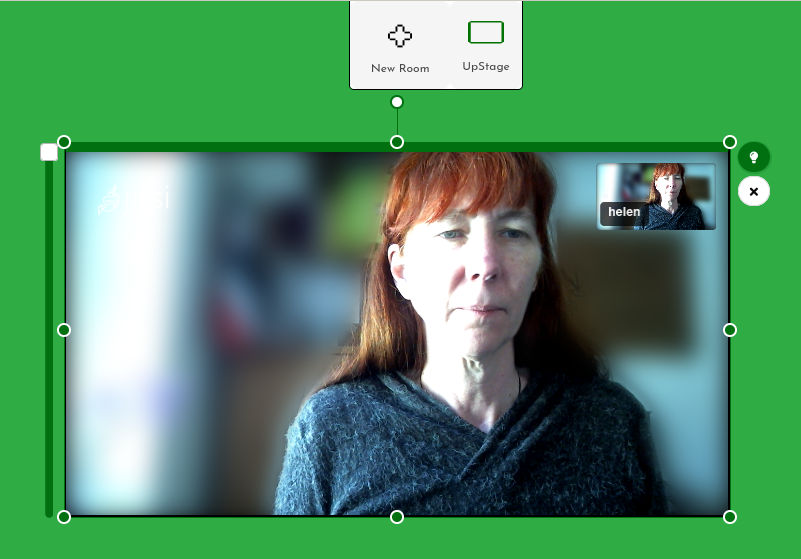
Jitsi tools
Roll your cursor over any part of the meeting window and the Jitsi tools will appear along the bottom as well as information in the centre top. These tools are only visible when your cursor is over the window, but anyone can do this, whether they’re a logged in player or an audience member. It’s important to understand how Jitsi works within UpStage if you’re going to use this tool in a live event.
Note: if you can see the green frame with the opacity slider and handles for adjusting the size of the window, you may not be able to access the Jitsi tools. Click on any icon in the left-hand toolbar so that the frame disappears, then roll your cursor over the meeting window without actually clicking on it. The Jitsi tools should now appear.
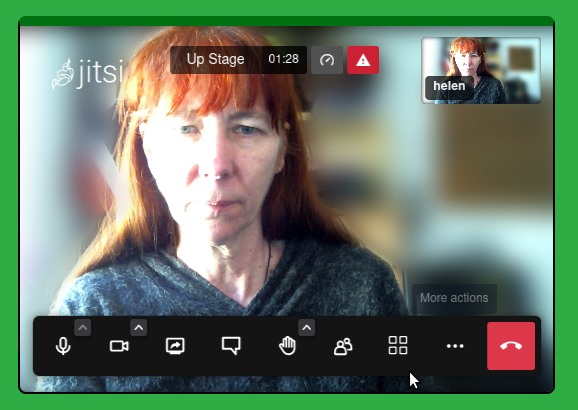
The Jitsi tools allow each individual (players AND audience) to mute or unmute their microphone, show or mute their webcam, alter the view (grid or speaker), share their screen, write in the Jitsi chat, raise their hand and other Jitsi functionalities.
As the Moderator (the player who has placed the meeting on the stage) you can set it so that everyone joining the meeting starts muted (mic and/or video); however others (players and audience) can then unmute themselves at any time.
There’s also the red hang-up button, to leave the meeting. If someone does this, they’ll still be in UpStage, but the Jitsi window on their screen will change to show the home screen from Jitsi. To re-enter the meeting, they can either reload the whole stage, or they can enter the name of the meeting room into the field on the Jitsi home page (another reason for giving your meeting room a meaningful name).
If you don’t want your audience to access the Jitsi tools, you could try using a prop, drawing or text object to cover the bottom area of the Meeting window. But remember that variables such as screen resolution and different browsers may mean that positioning varies; and this means the tools will also be hidden from you.
If you only need to use Meeting for audio, you can hide it behind the chat window, or make it small and/or transparent. This prevents or makes it more difficult for others to find the Jitsi tools.
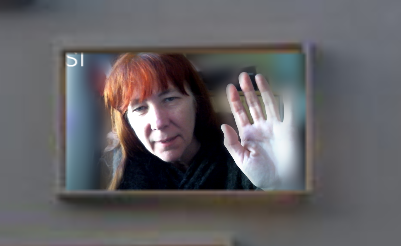
Individual stream
Place an individual stream on the stage
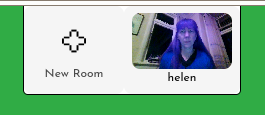 Click on the Stream icon in the left-hand toolbar and the overlay opens. You’ll be asked to share or allow your computer’s webcam and microphone. Once you’ve done this, you’ll see a thumbnail of your webcam in the overlay.
Click on the Stream icon in the left-hand toolbar and the overlay opens. You’ll be asked to share or allow your computer’s webcam and microphone. Once you’ve done this, you’ll see a thumbnail of your webcam in the overlay.
Drag the thumbnail onto the stage. You may see a buffering icon before your stream appears. As with other media, your stream is only visible to you until you activate the light bulb icon. Use the stream frame and the right-click menu to position your stream as you want, then click on the light bulb icon to reveal it to everyone else.
The right-click menu gives some of the same options as for other graphic objects on the stage (flipping, moving forward and back) as well as a local volume control. This is useful if you have proximal audience in the same physical space as you.
If you need to mute your stream for the online audience, your browser may allow you to do this by right-clicking on the stream’s thumbnail in the overlay, or via the icon in the browser’s URL bar that gives access to camera and mic permissions – disable mic access and you will not send an audio stream. If you are using OBS, you can adjust the audio output there.
Once your individual stream is on the stage with the light bulb activated, another player can operate it or remove it. This is useful if you are performing to the camera and can’t reach your keyboard.
Using OBS to stream
OBS Studio is an open source software for video recording and live streaming. If you want to enhance the streaming and video mixing possibilities within UpStage, you can try using OBS’s virtual camera tool as your video source.
You will need to download, install and configure OBS, then start the virtual camera. Once you have done this, OBS should appear as a camera option in your web browser when you select the Stream tool.